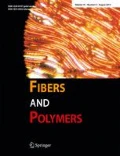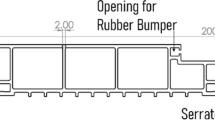Abstract
Flow analysis of profile extrusion is essential for design and production of a profile extrusion die. Velocity, pressure, and temperature distribution in an extrusion die are predicted and compared with the experimental results. A two dimensional numerical method is proposed for three dimensional analysis of the flow field within the profile extrusion die by applying a modified cross-sectional numerical method. Since the cross-sectional shape of the die is varied gradually, it is assumed that the pressure is constant within a cross-sectional plane that is perpendicular to the flow direction. With this assumption, the velocity component in the cross-sectional direction is neglected. The exact cross-sectional shape at any position is calculated based on the geometry of standard cross-sections. The momentum and energy equations are solved with proper boundary conditions at a cross-section and then the same calculation is carried out for the next cross-section using the current calculated values. An L-shaped profile extrusion die is produced and employed for experimental investigation using a commercially available polypropylene. Numerical prediction for the varying cross-sectional shape provides better results than the previous studies and is in good agreement with the experimental results.
Similar content being viewed by others
References
C. Rauwendaal, “Polymer Extrusion”, Hanser Publishers, New York, 1986.
G. Menges, U. Masberg, B. Gesenhues, and C. Berry, “Numerical Analysis of Forming Processes”, John Wiley & Sons, New York, 1984.
P. Hurez, P. A. Tanguy, and D. Blouin,Polym. Eng. Sci.,33(15), 971 (1993).
P. Hurez, P. A. Tanguy, and D. Blouin,Polym. Eng. Sci.,36(5), 626 (1996).
Z. Tadmor and C. G. Gogos, “Principles of Polymer Processing”, John Wiley & Sons, New York, 1979.
W. Michaeli, “Extrusion Dies: Design and Engineering Computations”, Hanser Publishers, New York, 1984.
F. P. Incropera and D. P. DeWitt, “Fundamentals of Heat and Mass Transfer”, 4th ed., John Wiley & Sons, New York, 1996.
K. K. Wang, S. F. Shen, C. Cohen, C. A. Hieber, and K. Himasekhar, “CIMP Progress report”,14, Cornell Univ., New York, 1988.
D. S. Burnett, “Finite Element Analysis”, Addison-Wesley, Massachusetts, 1987.
W. H. Press, S. A. Teukolsky, W. T. Vetterling, and B. P. Flannery, “Numerical Recipes in C”, 2nd ed., Cambridge Univ. Press, New York, 1992.
C. A. Heiber, L. S. Socha, S. F. Shen, K. K. Wang, and A. I. Isayev,Polym. Eng. Sci.,23(1), 20 (1983).
Author information
Authors and Affiliations
Corresponding author
Rights and permissions
About this article
Cite this article
Seo, D., Youn, J.R. Flow analysis of profile extrusion by a modified cross-sectional numerical method. Fibers Polym 1, 103–110 (2000). https://doi.org/10.1007/BF02875193
Received:
Revised:
Accepted:
Issue Date:
DOI: https://doi.org/10.1007/BF02875193




